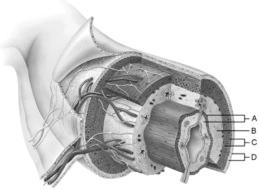
Mucosa
A
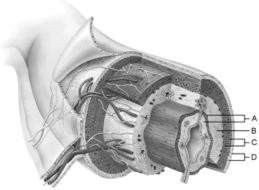
Duodenal glands found here
B
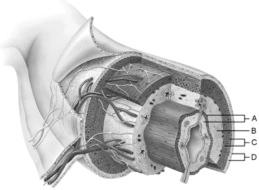
Smooth muscle layer
C
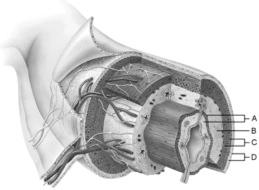
MALT found here
B
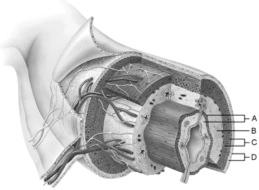
Serosa
D
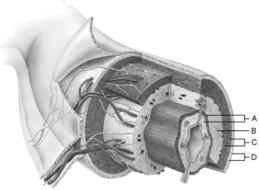
Area of the lamina propria
A
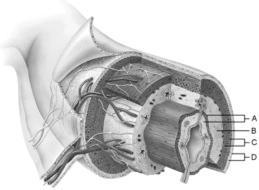
Continuation of the mesentery
D
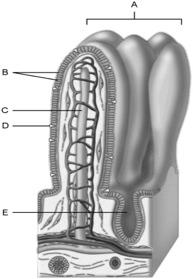
Absorptive cells that line the intestinal tract.
B
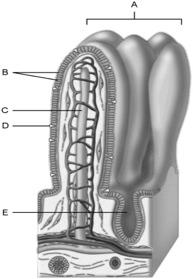
Cell type specialized to secrete mucus into the lumen of the intestinal tract.
D
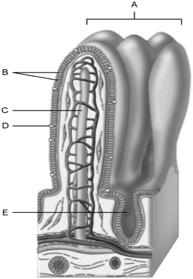
Structures that increase the absorptive area of the small intestine.
A
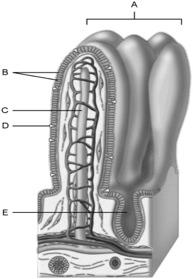
Wide lymph capillary located in the villus
C
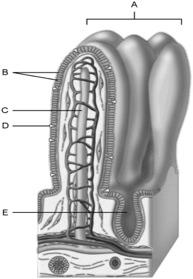
Paneth cells are found here
E
Wavelike smooth muscle contractions that move foodstuffs through the alimentary tube.
A) Peristalsis
B) Absorption
C) Digestion
D) Hydrolysis
A
Chemical or mechanical process of breaking down foodstuffs to substances that can be absorbed.
A) Peristalsis
B) Absorption
C) Digestion
D) Hydrolysis
C
Enzymatic breakdown of any type of food molecule.
A) Peristalsis
B) Absorption
C) Digestion
D) Hydrolysis
D
Process by which the products of digestion pass through the lumen of the gastrointestinal tract into the blood or lymph.
A) Peristalsis
B) Absorption
C) Digestion
D) Hydrolysis
B
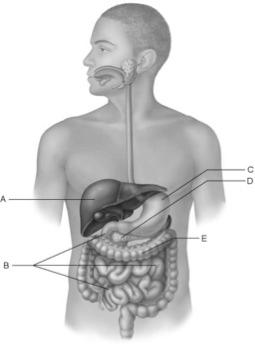
Produces enzymes that break down all categories of foodstuffs.
D
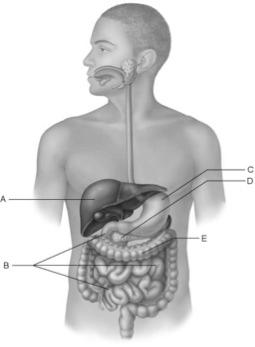
Increases surface area for absorption via villi and microvilli.
B
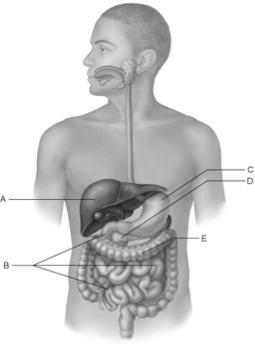
Bacteria process undigested chyme from the small intestine.
E
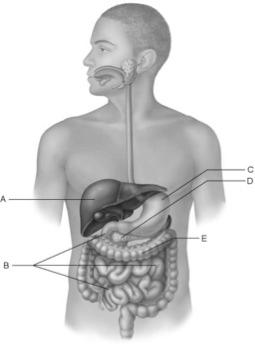
Only digestive structure with three muscle layers.
C
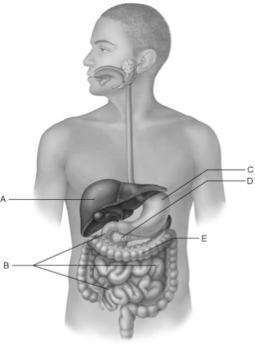
Receives blood via the hepatic portal system.
A
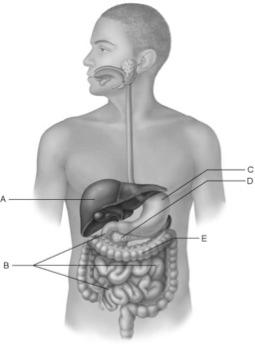
Contains the brush border enzymes that complete digestion of carbohydrates and proteins.
B
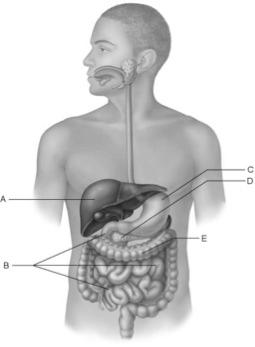
Main function is to filter and process the nutrient-rich blood delivered to it.
A
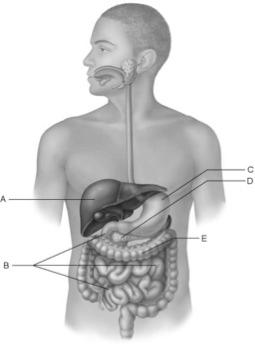
Produces intrinsic factor.
C
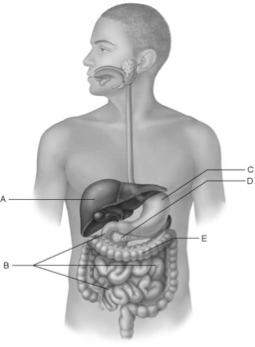
Produces a mucoid barrier.
C
True/False
Food is contained in the gastrointestinal tract from the time of ingestion until it is completely digested and the waste prepared for elimination.
True
True/False
The circular folds of the small intestine enhance absorption by causing the chyme to spiral, rather than to move in a straight line, as it passes through the small intestine.
True
True/False
As food passes through the digestive tract, it becomes less complex and the nutrients are more readily available to the body.
True
True/False
Some of the microbes that often invade other organs of the body are rarely found in the stomach. The reason for this is the presence of HCl.
True
True/False
Kupffer cells are found in the liver and are responsible for removing bacteria and worn-out cells
True
True/False
The pharyngeal-esophageal phase of swallowing is involuntary and is controlled by the swallowing center in the thalamus and lower pons.
False
True/False
All the chemical and mechanical phases of digestion from the mouth through the small intestine are directed toward changing food into forms that can pass through the epithelial cells lining the mucosa into the underlying blood and lymphatic vessels.
True
True/False
Pepsinogen is the precursor to the gastric enzyme for protein digestion and is secreted by the parietal cells.
False
True/False
The main chemical activity of the stomach is to begin the digestion of proteins.
True
True/False
The major role of absorption in the ileum is to reclaim bile salts to be recycled back to the liver.
True
True/False
The peritoneum is the most extensive serous membrane in the body.
True
True/False
Peyer's patches are found in the submucosa of the distal end of the small intestine.
True
True/False
The myenteric nerve plexus provides the major nerve supply to the GI tract wall and controls GI motility
True
True/False
The first teeth to appear are the deciduous teeth.
True
True/False
Dentin anchors the tooth in place
False
True/False
The digestive function of the liver is to produce bile.
True
True/False
The pancreas has both an endocrine and an exocrine function
True
True/False
Another term for swallowing is deglutition.
True
True/False
The intrinsic ability of visceral smooth muscle to exhibit the stress-relaxation response is termed plasticity
True
True/False
The stomach's contractile rhythm is set by pacemaker cells found in the spinal cord.
False
True/False
The major stimulus for production of intestinal fluid is distention or irritation of the intestinal mucosa by hypertonic or acidic chyme.
True
True/False
Most nutrients are absorbed through the mucosa of the intestinal villi by active transport.
True
True/False
Ionic iron is actively transported into the mucosal cells, where it binds to the protein ferritin, a phenomenon called the mucosal iron barrier.
True
True/False
Mumps is an inflammation of the parotid glands caused by myxovirus.
True
True/False
Fats significantly delay the emptying of the stomach.
True
True/False
The soft palate rises reflexively to open the nasopharynx when we swallow food.
False
The mechanical and chemical receptors that control digestive activity are located ________.
A) in the glandular tissue that lines the organ lumen
B) in the walls of the tract organs
C) in the pons and medulla
D) only in the esophagus because this is the only part of the tract that needs to change to accommodate food passage
B) in the walls of the tract organs
The function of the hepatic portal circulation is to ________.
A) carry toxins to the venous system for disposal through the urinary tract
B) collect absorbed nutrients for metabolic processing or storage
C) distribute hormones
D) return glucose to the general circulation when blood sugar is low
B) collect absorbed nutrients for metabolic processing or storage
The chemical and mechanical processes of food breakdown are called ________.
A) digestion
B) absorption
C) ingestion
D) secretion
A) digestion
When we ingest large molecules such as lipids, carbohydrates, and proteins, they must undergo catabolic reactions whereby enzymes split these molecules. This series of reactions is called ________.
A) absorption
B) secretion
C) chemical digestion
D) mechanical digestion
C) chemical digestion
The sheets of peritoneal membrane that hold the digestive tract in place are called ________.
A) mesenteries
B) lamina propria
C) serosal lining
D) mucosal lining
A) mesenteries
From the esophagus to the anal canal, the walls of every organ of the alimentary canal are made up of the same four basic layers. Arrange them in order from the lumen.
A) muscularis externa, serosa, mucosa, and submucosa
B) serosa, mucosa, submucosa, and muscularis externa
C) submucosa, serosa, muscularis externa, and mucosa
D) mucosa, submucosa, muscularis externa, and serosa
D) mucosa, submucosa, muscularis externa, and serosa
Which of the following is not a factor that helps create the stomach mucosal barrier?
A) thick coating of bicarbonate-rich mucus
B) tight junctions of epithelial mucosa cells
C) replacing of damaged epithelial mucosa cells
D) rennin
D) rennin
What part of the tooth bears the force of chewing?
A) crown
B) enamel
C) pulp
D) cementum
B) enamel
The capillaries that nourish the epithelium and absorb digested nutrients lie in the ________.
A) muscularis mucosae
B) serosa
C) adventitia
D) lamina propria
D) lamina propria
Which hormone causes an increased output of enzyme-rich pancreatic juice and stimulates gallbladder contraction to release bile?
A) gastrin
B) secretin
C) cholecystokinin
D) gastric inhibitor peptide
C) cholecystokinin
Choose the incorrect statement regarding bile.
A) Bile is both an excretory product and a digestive secretion.
B) Bile functions to emulsify fats.
C) Bile functions to carry bilirubin formed from breakdown of worn-out RBCs.
D) Bile contains enzymes for digestion.
D) Bile contains enzymes for digestion.
The absorptive effectiveness of the small intestine is enhanced by increasing the surface area of the mucosal lining. Which of the following accomplish this task?
A) plicae circulares and intestinal villi
B) the vast array of digestive enzymes
C) Brunner's glands
D) the rugae
A) plicae circulares and intestinal villi
Select the statement that is true concerning primary teeth.
A) There are 27 primary teeth, and the molars are permanent.
B) There are 24 primary teeth, and no new primary teeth appear after 13 months.
C) There are 20 primary teeth, and by 24 months of age most children have all 20.
D) There are 32 primary teeth, and most children lose these teeth due to decay because they are never very strong.
C) There are 20 primary teeth, and by 24 months of age most children have all 20.
Which of the following is true concerning the number and type of permanent teeth?
A) There are 32 permanent teeth, and the wisdom teeth are the last to emerge.
B) There are 27 permanent teeth, and the first molars are usually the last to emerge.
C) The number of permanent teeth is always equal to the number of primary teeth.
D) The number of upper permanent teeth is not equal to the number of lower permanent teeth.
A) There are 32 permanent teeth, and the wisdom teeth are the last to emerge.
Which of the following is not true of saliva?
A) cleanses the mouth
B) contains enzymes that begin the breakdown of proteins
C) moistens food and aids in compacting of the bolus
D) dissolves food chemicals so they can be tasted
B) contains enzymes that begin the breakdown of proteins
The salivary glands are composed of which two types of secretory cells?
A) goblet cells and squamous epithelial cells
B) parietal cells and glial cells
C) serous cells and mucous cells
D) cuboidal epithelium and ciliated columnar cells
C) serous cells and mucous cells
The solutes contained in saliva include ________.
A) only salts and minerals
B) only proteases and amylase
C) mucin, lysozyme, electrolytes, salts, and minerals
D) electrolytes, digestive enzyme, mucin, lysozyme, wastes, and IgA
D) electrolytes, digestive enzyme, mucin, lysozyme, wastes, and IgA
In addition to storage and mechanical breakdown of food, the stomach ________.
A) initiates protein digestion and denatures proteins
B) is the first site where absorption takes place
C) is the only place where fats are completely digested
D) is the first site where chemical digestion of starch takes place
A) initiates protein digestion and denatures proteins
Chyme is created in the ________.
A) mouth
B) stomach
C) esophagus
D) small intestine
B) stomach
Hydrochloric acid is secreted by which of the secretory cells of the stomach?
A) chief cells
B) parietal cells
C) serous cells
D) mucous neck cells
B) parietal cells
Gastrin, histamine, endorphins, serotonin, cholecystokinin, and somatostatin are hormones or paracrines that are released directly into the lamina propria. Which of the following cell types synthesize and secrete these products?
A) enteroendocrine cells
B) parietal cells
C) zymogenic cells
D) mucous neck cells
A) enteroendocrine cells
There are three phases of gastric secretion. The cephalic phase occurs ________.
A) before food enters the stomach and is triggered by aroma, sight, or thought
B) immediately after food enters the stomach, preparing the small intestine for the influx of a variety of nutrients
C) at the end of a large meal, and the juices secreted are powerful and remain in the GI tract for a long period of time
D) when the meal is excessively high in acids and neutralization is required
A) before food enters the stomach and is triggered by aroma, sight, or thought
Peristaltic waves are ________.
A) segmental regions of the gastrointestinal tract
B) churning movements of the gastrointestinal tract
C) pendular movements of the gastrointestinal tract
D) waves of muscular contractions that propel contents from one point to another
D) waves of muscular contractions that propel contents from one point to another
Gastrin is a digestive hormone that is responsible for the stimulation of acid secretions in the stomach. These secretions are stimulated by the presence of ________.
A) starches and complex carbohydrates
B) protein and peptide fragments
C) simple carbohydrates and alcohols
D) fatty acids
B) protein and peptide fragments
Pepsinogen, a digestive enzyme, is secreted by the ________.
A) chief cells of the stomach
B) parietal cells of the duodenum
C) Brunner's glands
D) goblet cells of the small intestine
A) chief cells of the stomach
You have just eaten a meal high in complex carbohydrates. Which of the following enzymes will help to digest the meal?
A) gastrin
B) amylase
C) cholecystokinin
D) trypsin
B) amylase
The ducts that deliver bile and pancreatic juice from the liver and pancreas, respectively, unite to form the ________.
A) portal vein
B) pancreatic acini
C) bile canaliculus
D) hepatopancreatic ampulla
D) hepatopancreatic ampulla
The enzymatic breakdown of any type of food molecule is called ________.
A) diffusion
B) active transport
C) hydrolysis
D) denatured
C) hydrolysis
Short-chain triglycerides found in foods such as butterfat molecules in milk are split by a specific enzyme in preparation for absorption. Which of the following enzymes is responsible?
A) rennin
B) pepsin
C) lipase
D) cholecystokinin
C) lipase
Parietal cells of the stomach produce ________.
A) mucin
B) pepsinogen
C) hydrochloric acid
D) rennin
C) hydrochloric acid
Hepatocytes do not ________.
A) produce digestive enzymes
B) process nutrients
C) store fat-soluble vitamins
D) detoxify
A) produce digestive enzymes
Which of the following is not a phase of gastric secretion?
A) cephalic
B) gastric
C) intestinal
D) enterogastric
D) enterogastric
Which vitamin requires intrinsic factor in order to be absorbed?
A) B12
B) K
C) A
D) C
A) B12
Chief cells ________.
A) occur in the intestine
B) produce HCl
C) are found in the basal regions of the gastric glands
D) produce mucin
C) are found in the basal regions of the gastric glands
Chemical digestion reduces large complex molecules to simpler compounds by the process of ________.
A) mastication
B) catabolism
C) anabolism
D) fermentation
B) catabolism
The ________ contains lobules with sinusoids (lined with macrophages) that lead to a central venous structure.
A) liver
B) spleen
C) pancreas
D) stomach
A) liver
If an incision has to be made in the small intestine to remove an obstruction, the first layer of tissue to be cut is the ________.
A) serosa
B) mucosa
C) muscularis externa
D) submucosa
A) serosa
The terminal portion of the small intestine is known as the ________.
A) duodenum
B) ileum
C) jejunum
D) pyloric sphincter
B) ileum
The dental formula for an adult is 2-1-2-3. What does the 1 stand for?
A) incisor tooth
B) molar tooth
C) premolar tooth
D) canine tooth
D) canine tooth
Digestion of which of the following would be affected the most if the liver were severely damaged?
A) lipids
B) carbohydrates
C) proteins
D) starches
A) lipids
________ is locally regulated in the blood by the active form of vitamin D, which acts as a cofactor.
A) Iron
B) Sodium
C) Phosphorus
D) Calcium
D) Calcium
Important peritoneal folds do not include the ________.
A) omenta
B) peritoneum
C) mesentery
D) round ligament
D) round ligament
The lamina propria is composed of ________.
A) loose connective tissue
B) dense irregular connective tissue
C) dense regular connective tissue
D) reticular connective tissue
A) loose connective tissue
________ is (are) not important as a stimulus in the gastric phase of gastric secretion.
A) Distension
B) Carbohydrates
C) Peptides
D) Low acidity
B) Carbohydrates
Pancreatic amylase does not get to the small intestine via the ________.
A) accessory pancreatic duct
B) main pancreatic duct
C) cystic duct
D) hepatopancreatic ampulla
C) cystic duct
The function of the goblet cells is to ________.
A) absorb nutrients from digested food and store them for future use
B) produce mucus that protects parts of the digestive organs from the effects of powerful enzymes needed for food digestion
C) secrete buffers in order to keep the pH of the digestive tract close to neutral
D) provide protection against invading bacteria and other disease-causing organisms that enter the digestive tract in food
B) produce mucus that protects parts of the digestive organs from the effects of powerful enzymes needed for food digestion
Which of the following is an essential role played by large intestine bacteria?
A) produce gas
B) absorb bilirubin
C) synthesize vitamin K and B-complex vitamins
D) synthesize vitamins C and D
C) synthesize vitamin K and B-complex vitamins
Nervous control of gastric secretion is provided by ________.
A) somatic neurons in the spinal cord
B) the vagus nerve and enteric plexus
C) the rubrospinal tracts
D) the reticulospinal and vestibulospinal tracts
B) the vagus nerve and enteric plexus
Which of the following are types of papillae on the tongue that contain taste buds?
A) fungiform and circumvallate
B) palatine and circumvallate
C) circumvallate and filiform
D) fungiform, circumvallate, and filiform
A) fungiform and circumvallate
Which of the following produce intrinsic factor?
A) parietal cells
B) zymogenic cells
C) mucous neck cells
D) enteroendocrine cells
A) parietal cells
Which of the following enzymes is specific for proteins?
A) dextrinase
B) amylase
C) trypsin
D) lipase
C) trypsin
Surgical cutting of the lingual frenulum would occur in which part of the body?
A) tongue
B) esophagus
C) nasal cavity
D) salivary glands
A) tongue
A fluid secreted into the small intestine during digestion that contains cholesterol, emulsification agents, and phospholipids is ________.
A) bile
B) pancreatic juice
C) intestinal juice
D) gastric juice
A) bile
The layer of the digestive tube that contains blood vessels, lymphatic nodes, and a rich supply of elastic fibers is the ________.
A) mucosa
B) submucosa
C) muscularis externa
D) serosa
B) submucosa
Which of the following is not characteristic of the large intestine? It ________.
A) does not contain villi
B) exhibits external muscular bands called teniae coli
C) is longer than the small intestine
D) has haustra
C) is longer than the small intestine
What stomach secretion is necessary for normal hemoglobin production in RBCs?
A) HCl
B) pepsinogen
C) intrinsic factor
D) gastric lipase
C) intrinsic factor
How are most nutrients absorbed through the mucosa of the intestinal villa?
A) simple diffusion
B) facilitated diffusion
C) active transport driven directly or indirectly by metabolic energy
D) bulk flow
C) active transport driven directly or indirectly by metabolic energy
Select the correct statement about the regulation of gastric secretion.
A) Vagus stimulation of the stomach results in decreased secretion of gastric juice.
B) The presence of food in the stomach prevents hormonal control of gastric secretion.
C) Gastric secretion can be stimulated before food has entered the mouth.
D) Gastric secretion is enhanced by very low pH (below a pH of 2).
C) Gastric secretion can be stimulated before food has entered the mouth.
Paneth cells ________.
A) are more common in the ileum than in the jejunum
B) are absorptive cells in the small intestine
C) secrete enzymes that kill bacteria
D) are located next to the lacteal in a villus
C) secrete enzymes that kill bacteria
Select the correct statement about digestive processes.
A) Enterogastrone is a hormone that helps increase gastric motility.
B) Pepsin is an enzyme produced by the stomach for the purpose of starch digestion.
C) Chyme entering the duodenum can decrease gastric motility via the enterogastric reflex.
D) All commonly ingested substances are significantly absorbed by the mucosa of the stomach
C) Chyme entering the duodenum can decrease gastric motility via the enterogastric reflex.
Chemical digestion in the small intestine involves ________.
A) a significant amount of enzyme secretion by the intestinal mucosa
B) cholecystokinin (CCK), an intestinal hormone responsible for gallbladder contraction
C) secretions from the spleen that contain all enzymes necessary for complete digestion
D) bile salts that help emulsify carbohydrates so that they can be easily digested by enzymatic action
B) cholecystokinin (CCK), an intestinal hormone responsible for gallbladder contraction
Select the correct statement about absorption.
A) Eighty percent of ingested materials have been absorbed by the end of the large intestine.
B) Carbohydrates diffuse across the villus epithelium and are then actively transported into blood capillaries.
C) If intact proteins are transported across the villus epithelium, an immune response may be generated.
D) Amino acid transport is linked to chloride transport.
C) If intact proteins are transported across the villus epithelium, an immune response may be generated.
Select the correct statement about electrolyte absorption.
A) Chlorine ion absorption is coupled to glucose and amino acid transport.
B) Potassium moves across the epithelium by active transport.
C) If vitamin B is not present, calcium is not absorbed.
D) Iron and calcium are absorbed mostly by the duodenum.
D) Iron and calcium are absorbed mostly by the duodenum.
You have just eaten french fries, buttered toast, ice cream, and whole milk. Which of the following glands would be active in helping you to digest this food?
A) the pancreas
B) the buccal glands
C) the thyroid gland
D) the parotid glands
A) the pancreas
The ingestion of a meal high in fat content would cause which of the following to occur?
A) Severe indigestion would occur, caused by the lack of sufficient digestive enzymes.
B) This type of food would cause secretion of gastrin to cease, causing digestive upset.
C) Bile would be released from the gallbladder to emulsify the fat in the duodenum.
D) The acid secretions from the stomach would be sufficient to digest this food
C) Bile would be released from the gallbladder to emulsify the fat in the duodenum.
The mucosa of the developing alimentary tube comes from ________.
A) ectoderm
B) mesoderm
C) endoderm
D) pachyderm
C) endoderm
A baby is admitted to the hospital with a history of projectile vomiting after each feeding. On examination, it is found that the sphincter controlling food passage from the stomach to the duodenum is thickened and does not open readily. Because of the baby's loss of gastric juice, his blood probably indicates ________.
A) acidosis
B) ketosis
C) alkalosis
D) dysphagia
C) alkalosis
Hormones or paracrines that inhibit gastric secretion include ________.
A) ACh
B) secretin
C) gastrin
D) histamine
B) secretin
Which of these is not part of the splanchnic circulation?
A) hepatic portal vein
B) inferior vena cava
C) superior mesenteric artery
D) celiac artery
B) inferior vena cava
Which of these is not a component of saliva?
A) lysozyme
B) a cyanide compound
C) defensins
D) nitric oxide
D) nitric oxide
There are some 20 known pathogens found in the large intestine; our Ig ________ antibody-mediated response restricts them from going beyond the mucosa and causing problems.
A) D
B) A
C) M
D) E
B) A
The longest portion of the small intestine is the ________.
ileum
________ is the principal enzyme for breaking down carbohydrates.
Amylase
________ cells of the stomach secrete HCl.
Parietal
The chief bile pigment is ________.
bilirubin
________ is another word for vomiting
Emesis
The portal triad contains ________.
a branch of the hepatic artery, a branch of the hepatic portal vein, and a bile duct.
________ cells are found in the sinusoids of the liver, and they remove debris from the blood as it flows past.
Kupffer
________ peritoneum covers the external surfaces of most digestive organs.
Visceral
The ________ ligament anchors a tooth in the alveolus of the jaw.
periodontal
The ________ phase of gastric secretions occurs before food enters the stomach.
cephalic (or reflex)
The round ligament is a remnant of the fetal ________.
umbilical vein